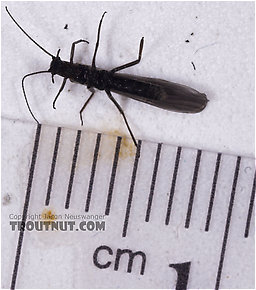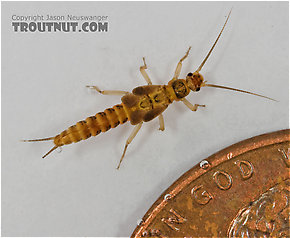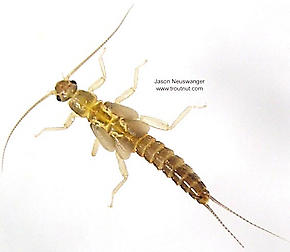Blog & Latest Updates
Fly Fishing Articles
Insects by Common Name


Stonefly Family Capniidae (Snowflies)
Taxonomic Navigation -?-
Kingdom
Animalia (Animals)
» Phylum
Arthropoda (Arthropods)
» Class
Insecta (Insects)
» Order
Plecoptera (Stoneflies)
» Family Capniidae (Snowflies)
| Genus in Capniidae | ||
| AllocapniaLittle Snowflies | 0 | 0 |
| CapniaLittle Snowflies | 0 | 0 |
| IsocapniaLittle Snowflies | 0 | 0 |
| UtacapniaLittle Snowflies | 0 | 0 |
6 genera aren't included.
Common Names
| Match | Common Name |
| Snowflies | |
| Little Snowflies | |
| Tiny Winter Blacks |
Capnia in the West and Allocapnia in the East are probably the most common genera of this prolific family.
Where & When
Regions: East, Midwest, West
Time Of Year (?): Late winter to mid-spring
Pictures of 10 Stonefly Specimens in the Family Capniidae:
Capniidae (Snowflies) Stonefly Adult View 6 Pictures
View 6 Pictures
 View 6 Pictures
View 6 PicturesCollected March 29, 2005 from Salmon Creek in New York
Added to Troutnut.com by Troutnut on April 7, 2006
Added to Troutnut.com by Troutnut on April 7, 2006
Capniidae (Snowflies) Stonefly Nymph View 4 Pictures
View 4 Pictures
 View 4 Pictures
View 4 PicturesCollected March 13, 2005 from Cascadilla Creek in New York
Added to Troutnut.com by Troutnut on April 5, 2006
Added to Troutnut.com by Troutnut on April 5, 2006
Capniidae (Snowflies) Stonefly Nymph View 3 Pictures
View 3 Pictures
 View 3 Pictures
View 3 PicturesCollected January 13, 2004 from the Namekagon River in Wisconsin
Added to Troutnut.com by Troutnut on January 25, 2006
Added to Troutnut.com by Troutnut on January 25, 2006
Recent Discussions of Capniidae
Little Black Stonefly pics 12 Replies »
Posted by Adirman on Apr 14, 2018 in the species Allocapnia granulata
Last reply on Apr 21, 2018 by Martinlf
Hey guys, went out on the Neversink for awhile today and had a look around, saw a lot of little dark flies, may be the little black stone fly? Hard to tell cuz looked like Caddis too. Looks like about a size 16? Any pics of available of this species would be great.
Thanks
Replylittle black stoneflies 5 Replies »Thanks
in the winter, we here in the east are told that little black stoneflies might be hatching, so we tie up neat little tiny black things to represent the dries. can anyone steer me to a proper pattern for the nymphs? or is any dark quite small generic nymph going to do the job?
and surely they have a sexy Latin name...
ReplyWinter Stones and the like 3 Replies »and surely they have a sexy Latin name...
Posted by DarkDun on Nov 20, 2006
Last reply on May 21, 2008 by Greenwolly
I like your site and all it offers. Would like you to come on down to the Southeast and identify our species of mayflies, caddis and plecoptera. Ours are a bit different in makeup than elsewhere and really need cataloging. We constantly are trying to compare our species to the northern hatches and it does not fit into their pattern. We are a month ahead of everywhere else and twice as long in many cases. Some hatches seem to be identifiable and then some defy easy categorization.
DarkDun
ReplyDarkDun
Your Thoughts On Capniidae:
Top 10 Fly Hatches
Top Gift Shop Designs
Eat mayflies.
Top Insect Specimens
Miscellaneous Sites
Troutnut.com is copyright © 2004-2024 Jason
Neuswanger (email Jason). See my FAQ for information about use of my images.
 privacy policy
privacy policy
